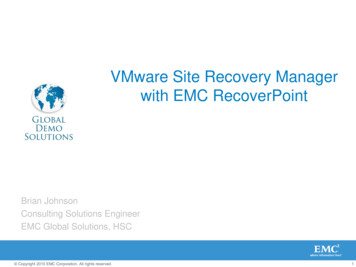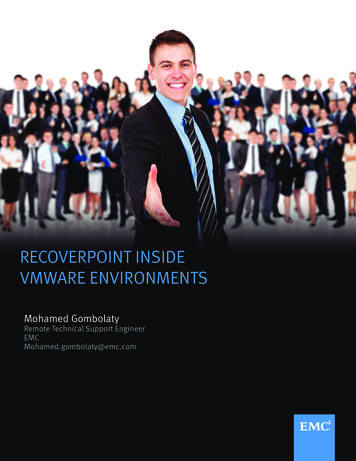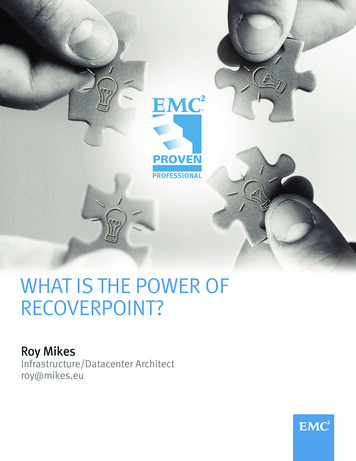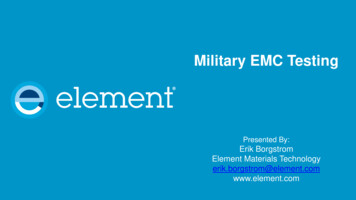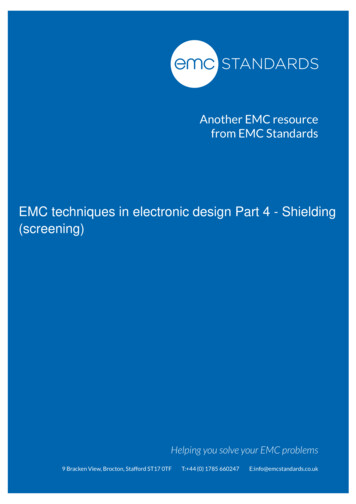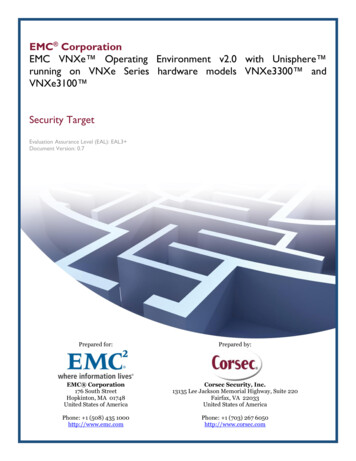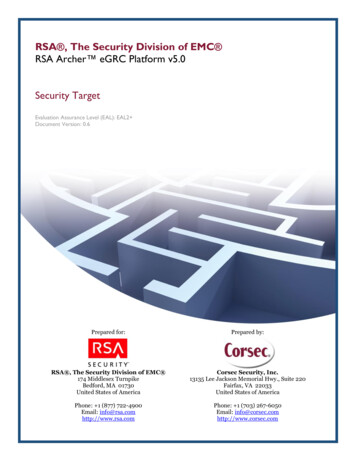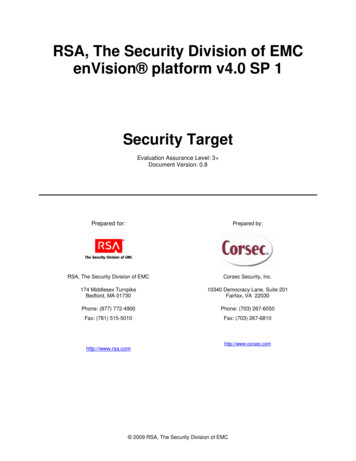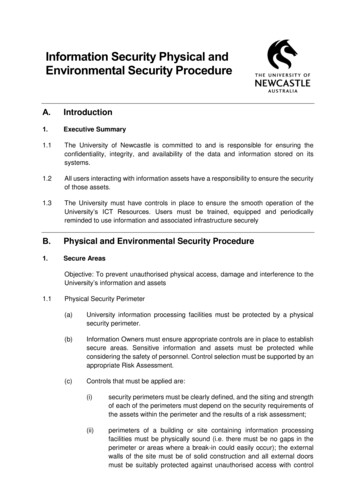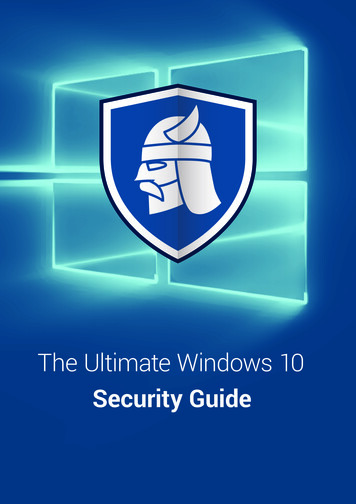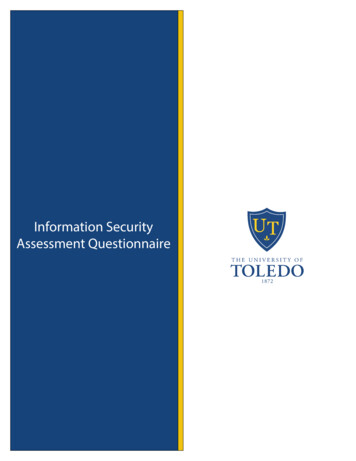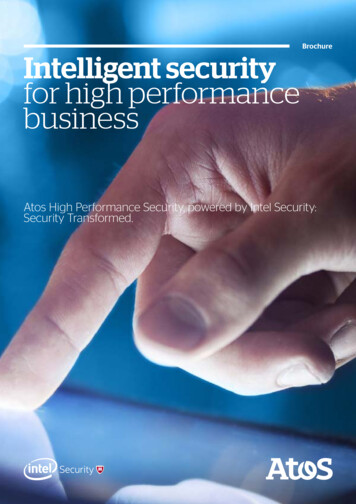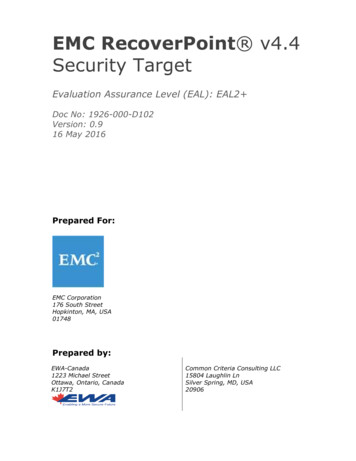
Transcription
EMC RecoverPoint v4.4Security TargetEvaluation Assurance Level (EAL): EAL2 Doc No: 1926-000-D102Version: 0.916 May 2016Prepared For:EMC Corporation176 South StreetHopkinton, MA, USA01748Prepared by:EWA-Canada1223 Michael StreetOttawa, Ontario, CanadaK1J7T2Common Criteria Consulting LLC15804 Laughlin LnSilver Spring, MD, USA20906
EMC RecoverPoint v4.4 Security TargetVersion: 0.9CONTENTS1SECURITY TARGET INTRODUCTION . 11.1DOCUMENT ORGANIZATION . 11.2SECURITY TARGET REFERENCE . 11.3TOE REFERENCE . 21.4TOE OVERVIEW . 21.5TOE DESCRIPTION. 42CONFORMANCE CLAIMS . 72.1 COMMON CRITERIA CONFORMANCE CLAIM . 72.2 ASSURANCE PACKAGE CLAIM . 72.3 PROTECTION PROFILE CONFORMANCE CLAIM . 73 SECURITY PROBLEM DEFINITION . 83.1 THREATS . 83.2 ORGANIZATIONAL SECURITY POLICIES . 83.3 ASSUMPTIONS . 94 SECURITY OBJECTIVES . 104.1 SECURITY OBJECTIVES FOR THE TOE . 104.2 SECURITY OBJECTIVES FOR THE OPERATIONAL ENVIRONMENT . 104.3 SECURITY OBJECTIVES RATIONALE. 115 EXTENDED COMPONENTS DEFINITION . 195.1EXTENDED FUNCTIONAL COMPONENTS. 195.2EXTENDED ASSURANCE COMPONENTS. 196SECURITY REQUIREMENTS . 206.1 CONVENTIONS . 206.2 TOE SECURITY FUNCTIONAL REQUIREMENTS . 206.3 SECURITY FUNCTIONAL REQUIREMENTS RATIONALE . 276.4 DEPENDENCY RATIONALE . 306.5 TOE SECURITY ASSURANCE REQUIREMENTS . 317 TOE SUMMARY SPECIFICATION . 337.1 TOE SECURITY FUNCTIONS . 33Doc No: 1926-000-D102Version: 0.9Date: 16 May 2016Page i of ii
EMC RecoverPoint v4.4 Security TargetVersion: 0.98TERMINOLOGY AND ACRONYMS . 358.1 ACRONYMS . 35LIST OF TABLESTable 1 – Virtual Hardware Requirements for vRPA . 4Table 2 - Logical Scope of the TOE. 6Table 3 - Threats . 8Table 4 – Organizational Security Policies . 8Table 5 – Assumptions . 9Table 6 – Security Objectives for the TOE . 10Table 7 – Security Objectives for the Operational Environment . 11Table 8 - Mapping Between Objectives, Threats, Organizational Security Policies,and Assumptions . 12Table 9 - Summary of Security Functional Requirements . 21Table 10 – TSF Data Access Permissions . 26Table 11 – Mapping of SFRs to Security Objectives . 28Table 12 – Security Objectives for the TOE . 30Table 13 - Functional Requirement Dependencies . 31Table 14 - EAL 2 Assurance Requirements . 32Table 15 - Acronyms . 36LIST OF FIGURESFigure 1 - EMC RecoverPoint Representative Deployment . 3Doc No: 1926-000-D102Version: 0.9Date: 16 May 2016Page ii of ii
EMC RecoverPoint v4.4 Security TargetVersion: 0.91 SECURITY TARGET INTRODUCTIONThis Security Target (ST) defines the scope of the evaluation in terms of theassumptions made, the intended environment for the TOE, the InformationTechnology (IT) security functional and assurance requirements to be met, andthe level of confidence (evaluation assurance level) to which it is asserted thatthe TOE satisfies its IT security requirements. This document forms thebaseline for the Common Criteria (CC) evaluation.1.1 DOCUMENT ORGANIZATIONSection 1, ST Introduction, provides the Security Target (ST) reference, theTarget of Evaluation (TOE) reference, the TOE overview and the TOE description.Section 2, Conformance Claims, describes how the ST conforms to theCommon Criteria and Packages. The ST does not conform to a ProtectionProfile.Section 3, Security Problem Definition, describes the expected environmentin which the TOE is to be used. This section defines the set of threats that arerelevant to the secure operation of the TOE, organizational security policies withwhich the TOE must comply, and secure usage assumptions applicable to thisanalysis.Section 4, Security Objectives, defines the set of security objectives to besatisfied by the TOE and by the TOE operating environment in response to theproblem defined by the security problem definitionSection 5, Extended Components Definition, defines the extendedcomponents which are then detailed in Section 6.Section 6, Security Requirements, specifies the security functional andassurance requirements that must be satisfied by the TOE and the InformationTechnology (IT) environment.Section 7, TOE Summary Specification, describes the security functions andassurance measures that are included in the TOE to enable it to meet the ITsecurity functional and assurance requirements.Section 8 Terminology and Acronyms, defines the acronyms andterminology used in this ST.1.2 SECURITY TARGET REFERENCEST Title:EMC RecoverPoint v4.4 Security TargetST Version:0.9ST Date:16 May 2016Doc No: 1926-000-D102Version: 0.9Date: 16 May 2016Page 1 of 36
EMC RecoverPoint v4.4 Security TargetVersion: 0.91.3 TOE REFERENCETOE Identification:EMC RecoverPoint 4.4 SP1 (h.138) with Gen5Hardware (100-564-200-03) or VMware vSphere 5.xTOE Developer:EMC CorporationTOE Type:Other Devices and Systems – Software and Hardware1.4 TOE OVERVIEWEMC RecoverPoint is an appliance-based product that provides real-time, blocklevel data replication for systems and devices in an enterprise storage areanetwork (SAN) environment. RecoverPoint runs on an out-of-band RecoverPointAppliance (RPA), and provides near-zero-data-loss protection both locally andremotely over a wide area network (WAN) as well as zero data loss synchronousreplication over IP or extended Fibre Channel links. It is also possible to runRPA software as a virtual appliance on VMware infrastructure; this is referred toas a virtual RPA (vRPA). The functionality of RPAs and vRPAs is the same.Data is forwarded to RPAs from storage devices or hosts by splitters, which issoftware that sends a copy of data being written to the RPAs. This enablesRecoverPoint to transparently perform real-time and continuous backups of theprotected storage.Up to 8 RPAs may be interconnected at a site to form a cluster. Each RPA is aphysical appliance (Gen5 hardware) or a VMware virtual machine instance.RPAs within a cluster are controlled and monitored by a single managementaccess point. The management access point executes on one of the RPAs in thecluster that is dynamically chosen.Up to 5 RPA clusters at different sites may be interconnected to form a system.The clusters within a system dynamically communicate amongst themselves toexchange data as directed by administrators.Replication can be performed locally, remotely, or both. With local replication, aSAN connects systems and devices to a local RPA for replication designed toallow operational recovery from logical corruptions such as human errors orviruses. With remote replication, geographically dispersed SANs are connectedby two or more RPA clusters, allowing recovery primarily from geographical orsite disasters.The following diagram shows a representative RecoverPoint system with 4clusters. The RPAs work in the following way:1. In New York, the splitters intercept all host writes to the storage, sendingthem to the RPAs in New York, and then to their normally designatedstorage volumes.2. The RPAs in New York make intelligent decisions regarding when and whatdata to transfer to each target destination. They base these decisions oneach RPAs continuous analysis of application load and resourceavailability, balanced against the need to prevent degradation of hostDoc No: 1926-000-D102Version: 0.9Date: 16 May 2016Page 2 of 36
EMC RecoverPoint v4.4 Security TargetVersion: 0.9application performance and to deliver maximum adherence to thespecified replication policies.3. The RPAs at Shanghai, London and Moscow receive the data anddistribute the data to the storage at each destination.Figure 1 - EMC RecoverPoint Representative DeploymentProtected volumes are organized into Consistency Groups, which define the typeof protection performed. In addition to data being stored locally and/orremotely, the Consistency Group may specify policies for restoration of data.RecoverPoint digitally signs replicated data for integrity and records data changejournals, allowing roll-back, recovery, and forensic analysis of data writes.RecoverPoint uses back-end storage for the replicated data as well as journalsand meta-data associated with the data. The back-end storage is provided bythe TOE Environment.Data can be restored to protected storage (rollback), or copies of data can bemade available for other purposes (e.g. testing, disaster recovery).Users interact with the RecoverPoint system via a CLI or browser GUI (known asUnisphere for RecoverPoint). Multiple user accounts are supported and each oneDoc No: 1926-000-D102Version: 0.9Date: 16 May 2016Page 3 of 36
EMC RecoverPoint v4.4 Security TargetVersion: 0.9is assigned a role; multiple roles are supported to limit the capabilities availableto different users. Users must provide a valid username and password at thebeginning of each session. The credentials are validated internally.Within each cluster, a single RPA provides the management interfaces for thecluster. An entire system can be managed from any of the clusters.Event logs are generated for user actions as well as replication events. Eventscan be viewed via the CLI. Events can also be transmitted to external systemsvia Syslog, SNMP Traps, and SMTP. Filters can be configured to determine whatevents are sent to the external systems.1.5 TOE DESCRIPTION1.5.1 Physical ScopeA RecoverPoint system includes two to five clusters, each including two to 8RPAs. RPAs provide interfaces for host connections, storage connections, andconnections to other RPAs/clusters. The RPAs in a cluster dynamically selectone RPA to provide the management interface for the cluster.RPAs within a cluster are required to be all hardware or all vRPA instances.Hardware RPAs are Gen5 hardware appliances. vRPAs are VMware virtualmachine instances running on ESXi systems that satisfy the minimumrequirements specified in Table 1.For hardware RPAs, the Gen5 appliance hardware and RecoverPoint software areincluded in the TOE boundary. When a vRPA is used, only the RecoverPointsoftware is included in the TOE boundary; the ESXi hardware and hypervisor arenot part of the TOE.1.5.2 TOE EnvironmentWhen a vRPA is used, the server hardware and hypervisor are part of the TOEEnvironment. vRPA is supported on VMware ESXi 5.x with vCenter 5.x. Thefollowing requirements must be satisfied for the system hosting the vRPA VM.ItemMinimum RequirementVirtual CPUs2RAM4GB for 2 or 4 CPUs; 8GB for 8CPUsNetwork Connections4 (LAN, WAN, iSCSI1, iSCSI2)Protected Storage1 or more EMC VNX OE v05.32.000.5.2 or later, with atleast one iSCSI portTable 1 – Virtual Hardware Requirements for vRPADoc No: 1926-000-D102Version: 0.9Date: 16 May 2016Page 4 of 36
EMC RecoverPoint v4.4 Security TargetVersion: 0.9The hosts and storage devices in the SANs that are connected to RecoverPointare part of the TOE Environment. It is the responsibility of the TOE Environmentto protect SAN traffic, administrator traffic with RPAs, and inter-RPA traffic(within a cluster and between clusters) from unauthorized disclosure ormodification.The RecoverPoint splitter is proprietary software that is installed on hosts and/orstorage subsystems. The RecoverPoint splitter is used to “split” the applicationwrites from hosts so that they are sent first to the RecoverPoint appliance andthen to their normally designated storage volumes. The Splitters enableRecoverPoint to transparently back up the protected storage and performrecovery operations.Users access RecoverPoint from workstations in the TOE Environment. For theCLI, the “PuTTY” utility is recommended.1.5.3 TOE GuidanceThe TOE includes the following guidance documentation: EMC RecoverPoint Installation and Deployment Guide EMC RecoverPoint Version 4.4 Administrator’s Guide EMC RecoverPoint Release 4.4 CLI Reference Guide EMC RecoverPoint Release number 4.4 Release Notes EMC RecoverPoint Release number 4.4 Security Configuration Guide EMC RecoverPoint 4.4 Common Criteria Supplement1.5.4 Logical ScopeFunctional ClassesDescriptionSecurity AuditAudit entries are generated for security related events, andcan be reviewed by authorized users.Volume ReplicationReplication is performed for configured volumes. Up to 4simultaneous copies may be maintained. The primaryvolume may be restored to a point in time or snapshot.Each of the copies may be used for testing or to act as afailover instance.Identification andAuthenticationAdministrators must identify and authenticate prior to TOEaccess. GUI users must supply a valid username andpassword. CLI users can supply a valid username andpassword or an SSH Fingerprint.Doc No: 1926-000-D102Version: 0.9Date: 16 May 2016Page 5 of 36
EMC RecoverPoint v4.4 Security TargetVersion: 0.9Functional ClassesDescriptionSecurity ManagementThe TOE provides management capabilities via GUI and CLIinterfaces. Multiple roles are supported to provide varyinglevels of access to data and functions.TOE AccessUser sessions may be terminated by users, or by the TOE ifthey are inactive longer than the inactivity limit. Aconfigured banner is displayed to users during login.Table 2 - Logical Scope of the TOE1.5.5 Required Configuration SettingsThe following options must be configured:1. The Security Level must be set to High.2. Event Filters must allow generation of events for the following eventtypes:a. Login activity (Successful and failed logins, logging out)b. Configuration changesc. Restoration actionsd. Failure to send event messages to external systems3. Custom roles are not configured; the pre-configured roles are used.1.5.6 Functionality Excluded from the Evaluated ConfigurationIn addition to internal user accounts, RecoverPoint user accounts may beintegrated with external LDAP servers for credential validation.In addition to Gen5 hardware, RecoverPoint is also supported on Gen6hardware.The following product features are excluded from this evaluation: REST APIHigh AvailabilityEMC Secure Remote Support (ESRS)Call-HomeDoc No: 1926-000-D102Version: 0.9Date: 16 May 2016Page 6 of 36
EMC RecoverPoint v4.4 Security TargetVersion: 0.92 CONFORMANCE CLAIMS2.1 COMMON CRITERIA CONFORMANCE CLAIMThis Security Target claims to be conformant to Version 3.1 of Common Criteriafor Information Technology Security Evaluation according to: Common Criteria for Information Technology Security Evaluation, Part 1:Introduction and General Model; CCMB-2012-09-001, Version 3.1,Revision 4, September 2012 Common Criteria for Information Technology Security Evaluation, Part 2:Security Functional Components; CCMB-2012-09-002, Version 3.1,Revision 4, September 2012 Common Criteria for Information Technology Security Evaluation, Part 3:Security Assurance Requirements CCMB-2012-09-003, Version 3.1,Revision 4, September 2012As follows: CC Part 2 conformant CC Part 3 conformantThe Common Methodology for Information Technology Security Evaluation,Version 3.1, Revision 4, September 2012 [CEM] has to be taken into account.2.2 ASSURANCE PACKAGE CLAIMThis Security Target claims conformance to Evaluation Assurance Level 2 augmented with ALC FLR.2 Flaw Reporting Procedures.2.3 PROTECTION PROFILE CONFORMANCE CLAIMThe TOE for this ST does not claim conformance with any Protection Profile (PP).Doc No: 1926-000-D102Version: 0.9Date: 16 May 2016Page 7 of 36
EMC RecoverPoint v4.4 Security TargetVersion: 0.93 SECURITY PROBLEM DEFINITION3.1 THREATSTable 3 lists the threats addressed by the TOE. Mitigation to the threats isthrough the objectives identified in Section 4.1 Security Objectives.ThreatDescriptionT.EAVESA malicious user could eavesdrop on network traffic to gainunauthorized access to TOE data.T.IMPCONAn unauthorized user may inappropriately change theconfiguration of the TOE causing potential unauthorized dataaccesses to go undetected.T.PRIVILAn unauthorized user may gain access to the TOE and exploitsystem privileges to gain access to TOE security functions anddata.T.UNAUTH ACCESSA server may attempt to access user data (volumes) that it isnot authorized to access.Table 3 - Threats3.2 ORGANIZATIONAL SECURITY POLICIESOrganizational Security Policies (OSPs) are security rules, procedures, orguidelines imposed upon an organization in the operational environment. Table4 lists the OSPs that are presumed to be imposed upon the TOE or itsoperational environment by an organization that implements the TOE in theCommon Criteria evaluated configuration.OSPDescriptionP.ACCACTUsers of the TOE shall be accountable for their actions within theTOE.P.MANAGEThe TOE shall only be managed by authorized users.P.PROTCTThe TOE shall be protected from unauthorized accesses anddisruptions of TOE data and functions.P.REPLICATEThe TOE shall replicate volumes and enable rollback and testingof volumes.Table 4 – Organizational Security PoliciesDoc No: 1926-000-D102Version: 0.9Date: 16 May 2016Page 8 of 36
EMC RecoverPoint v4.4 Security TargetVersion: 0.93.3 ASSUMPTIONSThe assumptions required to ensure the security of the TOE are listed in Table 5.AssumptionsDescriptionA.MANAGEThere will be one or more competent individuals assigned tomanage the TOE and the security of the information it contains.A.NETWORKThe SAN devices will be interconnected by a segregated SANthat protects the traffic from disclosure to or modification byuntrusted systems or users.A.NOEVILThe authorized administrators are not careless, willfullynegligent, or hostile, and will follow and abide by the instructionsprovided by the TOE documentation.A.PROTCTThe hardware and software critical to TOE security policyenforcement will be protected from unauthorized physicalmodification.Table 5
RecoverPoint to transparently perform real-time and continuous backups of the protected storage. Up to 8 RPAs may be interconnected at a site to form a cluster. Each RPA is a physical appliance (Gen5 hardware) or a VMware virtual machine instance. RPAs within a cluster are cont
